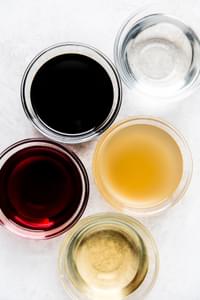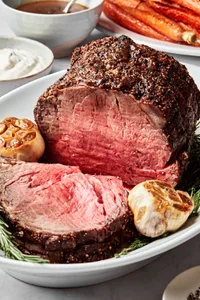Pantry Essentials: The TMP Guide to Vinegars
Today we’re taking a deep dive into the world of vinegars—which one to use when, and the five vinegars (yes, five!) we always have in our kitchen.
We’ve shared hundreds of recipes here on The Modern Proper, and the internet is populated with, what? Maybe millions of recipes? Probably more like billions. But the truth is, every recipe out there can be whittled down to just one fundamental recipe: sweet + salty + bitter + (some would argue) umami + sour. Every great recipe is a balancing act between the five tastes, and today we want to talk about one of our favorite tastes (though it can be a divisive one): sour.
Acidity brings brightness—it can make a dish sing with sharpness, or a make our mouths water with its lively tang. It also plays a key role in some trickier recipes, like meringue for example, where the acidity from a small drizzle of vinegar provides the stability that egg whites need to whip up into satiny, crisp clouds. While acidity can come from other sources—like citrus juice—most often it’s vinegar that lends acidity to food.
Which vinegar you use really matters! Some vinegars, like rice vinegar, add sweetness as well as sharp sourness. Some—like distilled white vinegar—are pure, puckery, punch. So, which ones do we reach for again and again? Which vinegar do you use make a classic vinaigrette? Where does vinegar come from? How is vinegar made? So many questions about vinegar! Luckily, we’ve got all the answers. Read on!
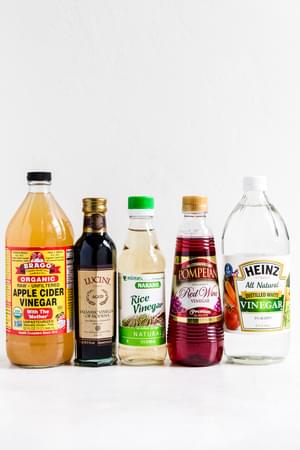
What is Vinegar Made Of?
Bacteria + alcohol + oxygen = vinegar. What that really means is that vinegar is the result of fermentation. It can be made from just about any liquid containing sugar or starch, which are what feeds the bacteria that cause fermentation. The word “vinegar” comes from the French vin agre, meaning “sour wine”, which is probably exactly what the first vinegars were—wine that was exposed to the air and left to sour, which resulted (accidentally, at least at first) in vinegar.
The flavor of a finished vinegar depends heavily on two things:
- The base liquid it is made from.
- The type of bacteria that is added to cause the fermentation that will transform that starchy or sugary liquid into vinegar.
There are as many vinegars in the world as there are tastes, cuisines and appetites. But, today we’re going to keep the focus on the five vinegars we use the most, and that we think every well-stocked pantry should have. So, without further ado we give you:
The Five Vinegars Every Pantry Needs
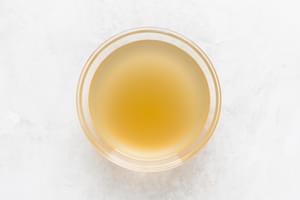
Apple Cider Vinegar
Although it is assertively sour, we love the slight sweetness that underlies the sharpness of apple cider vinegar. It’s a fantastic vinegar for dressing summery, bright salads, and goes well with sweet things, too. It’s widely available, inexpensive, and it just might be really good for you, too. What’s not to love? This bottle is a classic, and it’s the one we always have on-hand.
Benefits of Apple Cider Vinegar
So, like all things nutrition-related, this is complicated. But! It does seem like apple cider vinegar has some unique health benefits, although more study is needed. If you’re curious about the health benefits of apple cider vinegar, here’s what you should know:
- Buy the kind of apple cider vinegar that has the “mother” in it. The “mother” is a mass of the bacteria that fermented the apple cider into vinegar—a mass of good bacteria! It may not sound super appetizing, but it is a source of probiotics and therefore quite good for you.
- It is totally fine, and possibly beneficial, to drink a small amount of apple cider vinegar before meals. Stir one tablespoon of apple cider vinegar into eight ounces of water and drink that before a meal. That amount, diluted, certainly won’t hurt you and it may even help to regulate your blood sugar.
- Don’t over do it! Apple cider vinegar is still a strong acid. It can corrode teeth and really upset your stomach if you take it in large quantities. A little goes a long way.
Our Favorite Recipes That Use Apple Cider Vinegar
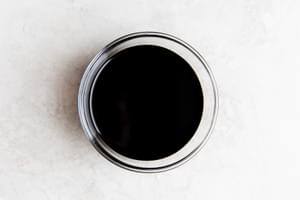
Balsamic Vinegar
Hailing originally from Modena in Italy, balsamic vinegar is also supposedly a healthy elixir—the name “balsamic” itself means health-giving. As with many of Italy’s most iconic foods, the Italian government has strict labeling standards for any vinegar labeled “balsamic”. Traditional, true balsamic vinegars can only be made in the Reggio Emilia region of Italy (where the city of Modena is), and are made from local grape varieties that are harvested and then cooked down to about half of their original volume. The resulting grapey slurry is then aged slowly in a series of barrels—each of which imparts its own perfume to the fermenting grape must. Many seasons pass—warm summers bring evaporation, and cool winters give the vinegar time to mature. Slowly, slowly, a precious, darkly dense and syrupy vinegar emerges. Traditional balsamic—marked with the label “aceto balsamico tradizionale”—made in this way will set you back a bit, although it is worth the splurge and makes a great gift for your food-loving friends.
For everyday cooking, look for bottles labeled “condimento” or “I.G.P.” balsamic—both indicate high quality balsamic vinegar. This is what you want to use for salad dressings or marinades, for drizzling on top of olive oil for dipping bread, and so on. If you do wind up with a bottle of the super concentrated, syrupy, expensive “tradizionale” balsamic, reserve it for super-special uses and don’t use it for cooking. Heat will destroy some of the vinegars' nuance. Instead, pour a little on vanilla ice cream for a tangy-creamy-sweet-savory dessert guaranteed to transport you (at least mentally) right into the midst of a warm evening on a glowy Italian piazza.
Our Favorite Recipes That Use Balsamic Vinegar
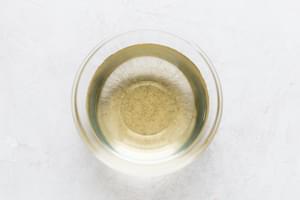
Rice Vinegar
Mild and sweet, rice vinegar is a staple of Asian cuisine. If you’re curious about cooking Asian food at home, rice vinegar is absolutely a must-have. Its delicate flavor is unique and hard to replace, and (bonus!) is super kid-friendly, too! Try whipping up a vinaigrette with rice vinegar, a little soy sauce and a good pour of sesame oil—coat your favorite greens with a generous pour of that lovely sweet-salty emulsion, and you just might find that your kids like salad after all. Rice vinegar is also widely available as “seasoned rice vinegar”, which is (just as it sounds) rice vinegar that has been flavored with salt and sugar. Both plain and seasoned rice vinegar are mild in flavor—we love the easy boost-in-deliciousness that seasoned rice vinegar gives to every dish it touches.
Our Favorite Recipes That Use Rice Vinegar
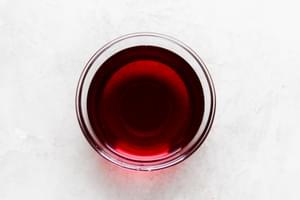
Red Wine Vinegar
Francophiles of the world, écoute-moi! Red wine vinegar is the vinegar for you! Just a splash of sharp, almost-herbaceous red wine vinegar is a magical thing—it can transform even the humblest plate of plain lentils into a silky, flavorful lentil salad worthy of the quaintest Parisienne bistro. Made from—you guessed it—red wine, red wine vinegar may be somewhat reminiscent of the type of red wine it was made from, although it is usually quite sharply sour, too, so don’t expect a ton of nuance in flavor or variation between brands. The beauty of red wine vinegar, in many ways, is that very bold assertiveness—just a splash adds a powerful dose of awakening brightness to a dressing or marinade. Try using it it place of a dash of hot sauce or a sprinkle of salt—it is a guilt-free way to enhance and illuminate otherwise-muted flavors.
Our Favorite Recipes That Use Red Wine Vinegar

Distilled White Vinegar
It helps you dye Easter eggs, pickle cucumbers AND clean your floor—distilled white vinegar isn’t just a top five pantry item, it’s a top five household must-have. Aggressively sour—really, it deserves a stronger word than “sour”—distilled white vinegar is strong enough to clean and disinfect, which means it is not something you’ll be dousing most meals with, at least we hope not! And certainly not in any large quantity. However, it can play a really important role in cooking, thanks to its acidic strength and purity. A splash of vinegar in the water a classic way to ensure a perfectly poached egg, and it can be used to give structure and stability to egg white-based confections like meringue and royal icing. Lending acidity, but not much flavor, distilled white vinegar is also the ideal blank slate for that summeriest of projects—pickling! We always have a big jug in the pantry, and seem to find more uses for it with each passing day. How do you like to use it?
Our Favorite Recipes That Use Distilled White Vinegar
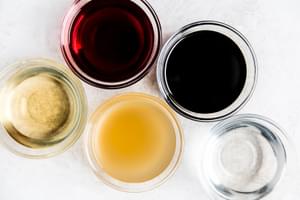
More Pantry Essentials?
Check out our other guides:
Pantry Essentials: Dry Goods
Pantry Essentials: Canned Goods
Pantry Essentials: The TMP Guide to Cooking Oils
Pantry Essentials: Five Spices We Always Have in Our Kitchen.
Our Favorite Recipes with Vinegar
- Quick Pickles are perhaps the quintessential way to use vinegar. Fast, easy and super satisfying—you’ll never go back to store bought.
- Apple cider vinegar and red wine vinegar team up to make this quick-pickled red cabbage, the perfect zingy contrast to these spicy, rich Lamb Burgers with Harissa Mayo.
- Is there anything more summery than a big plate of grilled vegetables? Grilled Asparagus with Balsamic Reduction is a delicious, simple way to let Italy’s favorite vinegar show off a little.
- Red wine vinegar works its marination magic on these elegant, wildly flavorful Chimichurri
- Vanilla-Plum Shrub.
- The simple apple cider vinegar-honey vinaigrette that we use to dress our Butter Lettuce Salad is one for the ages. It goes beautifully on just about any salad.
What Vinegars Do You Swear By?
What are your favorite ways to cook with vinegar? Share your thoughts with us in the comments or tag us on Instagram @themodernproper and #themodernproper.
